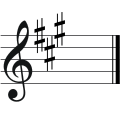A major
A major is a key of the major family, based on the root note a. The key of A major is written in musical notation with three crosses (f-sharp, c-sharp, g-sharp). The corresponding scale and the fundamental chord of this key (the tonic a-cis-e) are also designated by the term A major.

![]()
![]()
![]()
![]()
![]()
![]()
![]()
![]()
![]()
![]()
![]()
![]()
![]()
![]()
![]()
A major is often described as festive, bright and radiant, but see the article Key Character. A major is a particularly suitable key for song accompaniment on the guitar, since the bass notes of the basic A major cadence (d, e, a) correspond to the three lowest - and then empty - strings of the guitar.
Key classification
| Keys and their accidentals | |||||||||||||||
| Portent: | 7 ♭ | 6 ♭ | 5 ♭ | 4 ♭ | 3 ♭ | 2 ♭ | 1 ♭ | 0 ♭/♯ | 1 ♯ | 2 ♯ | 3 ♯ | 4 ♯ | 5 ♯ | 6 ♯ | 7 ♯ |
| Major keys: | Ces | Ges | Des | As | It | B | F | C | G | D | A | E | H | F# | C sharp |
| Minor keys: | as | it | b | f | c | g | d | a | e | h | F# | cis | gis | dis | ais |
Questions and Answers
Q: What is a major?
A: A major (or the key of A) is a major scale with a base note of A. Its key signature has three sharps.
Q: What is the relative minor of A-major?
A: The relative minor of A-major is F-sharp minor.
Q: How many symphonies are in the key of A-major?
A: There are not as many symphonies in A major as in D major or G major, but more than other sharp keys. Beethoven's Symphony No. 7, Bruckner's Symphony No. 6 and Mendelssohn's Symphony No. 4 are almost all the symphonies in this key in the Romantic era.
Q: What works did Mozart compose in A Major?
A: Mozart composed his Clarinet Concerto and Clarinet Quintet both in A Major.
Q: Why does Peter Cropper say that A Major is "the fullest sounding key for the violin"?
A: Peter Cropper said that A Major "is the fullest sounding key for the violin" because it produces a fuller sound than other keys when played on a violin.
Q: According to Christian Friedrich Daniel Schubart, what type of emotions can be expressed through music written in this key?
A: According to Christian Friedrich Daniel Schubart, music written in this key can express emotions such as declarations of innocent love, hope of seeing one's beloved again when parting, youthful cheerfulness and trust in God.
Q: How are timpani normally set when playing music for orchestra that is written in this key?
A: When playing music for orchestra that is written in this Key of A Major, timpani are normally set to play notes an octave apart - usually an 'A' and an 'E'. In most other keys they would be set a fourth apart instead
Search within the encyclopedia














